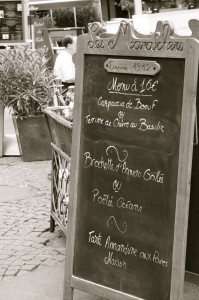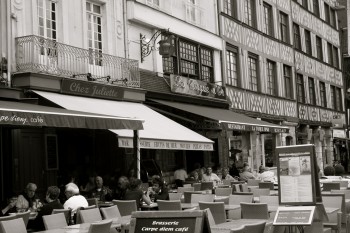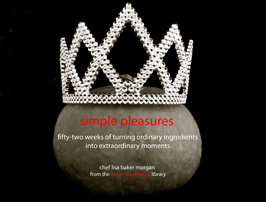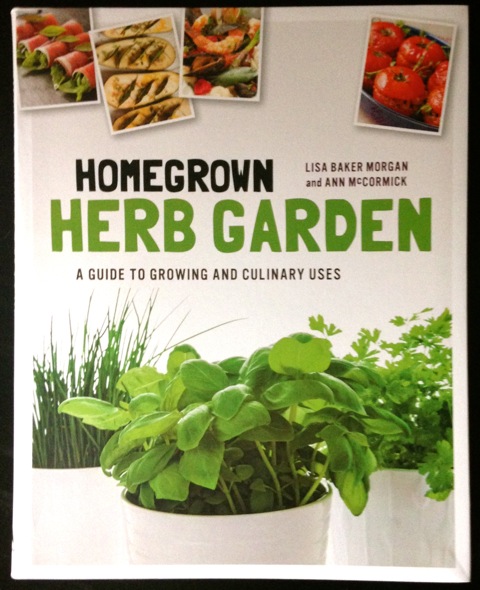
C’est quoi ce truc sur la carte?
(what is that on the menu ?)
How many times have you stared at a French menu, scanning it for foods you recognized, only to order something familiar to you rather than trying something new. Steak au poivre avec pommes frites? It seemed easier than asking the waiter and less problematic than ending up with tripe or sweetbreads, or some other soft organ from an unknown animal. Worse yet, did you chose a restaurant because it posted an English menu?
Taking the safe route deprives you of the experience of learning and discovering something new. True, the internet and our hand-held devices allow us to review a menu, have it translated, or even pull it up on your phone while at dinner. However, this assumes many things including that the current menu is posted, that the translations are correct, or that you will have a working phone (and really wouldn’t you rather enjoy your meal than be glued to your phone?). Better to arm yourself with a little knowledge, making your dependence upon outside sources unnecessary.
This section is dedicated to understanding French menus. Even if you do not speak French, you can learn some tips that will help you to understand what you can expect (what dish is comprised of and/or how it was prepared). This way you can make an informed decision rather than a decision based upon fear, routine, or speculation. Essayez quelque chose de nouveau et mangez bien (try something new and eat well).
Je vous souhaite un bon appétit !
LM

“à la . . . ”
(in the manner/style of)
(part I)
If you see the phrase “à la . . . ” after a food it means one of two things: (1) the manner or style in which the food was prepared; or (2) a secondary item. This section is devoted to discussing the former. The manner or style reference can refer to: (a) regional cuisine (a particular food or food preparation that a town or region is known for); or (b) a particular way or technique of preparing food or the use of particular ingredients. This list will be updated often, so be sure to check back.
à l’Allemande
Means that the item is served in/or withAllemande sauce. Allemande sauce is a white sauce made from velouté (made with veal or chicken stock and blonde roux) with the addition of a liaison of egg yolks and cream. Allemande sauce is often used with fricassée dishes.
Common menu items include: poulet à lAllemande (chicken with Allemande sauce).
à l’Alsacienne
Means in the style of Alsace (north-eastern of France next to Strasbourg). These dishes are garnished with food commonly associated with Alsace such as cabbage, sauerkraut, ham, charcuterie, bacon, and savory tarts.
Common menu items include: noques à l’Alsacienne (dumplings similar to gnochi, which are boiled and served with cheese and browned butter).
à l‘ancienne
Usually refers to fricassées (chicken, lamb or veal) garnished with small onions, mushrooms, and sometimes carrots. It also refers to savory tarts with have been blind-baked (without the filling) and then filled with different items ranging from sweetbreads (thymus gland), kidneys, scrambled eggs, and velouté.
Common menu items include: poulet à l’ancienne (chicken with Allemande sauce with onions and carrots); oeufs brouillés à l’ancienne (savory tart filled with scrambled eggs, chicken kidneys, and velouté sometimes served with fried cockscomb (the topnotch of a rooster)).
à la Bourguignonne
Means the food was cooked as they do in the region of Burgundy. In particular, cooked in red wine (Burgundy wine) usually with bacon, mushrooms and small onions. Bourguignonne sauce is a strained red wine reduction sauce flavored with bacon, onions and mushrooms.
Common menu items include: Boeuf Bourguignon (beef braised in red wine with vegetables, usually carrots, onions, and mushrooms although Boeuf Bourguignon is not a regional specialty of Burgundy); Escargots de Bourgogne (snails served in a Bourguignonne sauce); poulet à la Bourguignonne (chicken simmered in red wine and served with Bourguignonne sauce made from cooking liquid); oeoufs à la Bourguignonne (eggs poached in red wine or eggs served with Bourguignonne sauce); poisson à la Bourguignonne (fish served with a Bourguignonne sauce made with fish stock).
à la casserole
Means that the food was cooked in a cocotte (an earthenware pot). A sauce or jus is made from the cooking liquid/drippings and then the food and sauce is returned to the cocotte and served “family style.”
Common menu items include: poulet à la casserole (chicken cooked and served en cocotte).
à la diable
Means that the food was prepared and served in a sauce (it can be a creamy or a red sauce) that has been heavily spiced usually with cayenne pepper.
Common menu items include: crabe à la diable (crab with peppers and cayenne), poulet à la diable (chicken with peppers and cayenne).
à la Flamande
Refers to the style of cooking in northern France and generally means that the item is garnished with flavors such as stuffed rolls of green cabbage, carrots, pork belly, sliced sausage. It can also refer to a way of preparing asparagus with egg yolks passed through a sieve.
Common menu items include: Boeuf à la Flamande (beef braised with cabbage, turnips and carrots); asp erges à la Flamande (boiled asparagus melted butter, sieved egg yolks and parsley); chou à la Flamande (braised cabbage with apple slices).
à la fricassée
Means that the food (usually chicken) has been cut up and cooked first in butter (usually without color) and then simmered and served in a white sauce made from the cooking liquid, generally bound with a liaison of egg yolks and creme.
Common menu items include: fricassée Périgourdine (browned and simmered goose or duck legs usually served in a hearty soup).
à la Florentine
Protein (fish or eggs usually) served with cooked spinach
Common menu items include: oeufs à la Florentine (poached eggs with spinach).
à la Grecque
Means the food was inspired by the Mediterranean flavors of Greece (i.e., feta, black olives, cucumbers, tomatoes, capers). Very similar to Provençale cuisine except in the south they use chevre and nicoise olives rather than Kalamata olives and Feta.
Common menu items include: tomates à la Grecque (roasted tomatoes stuffed with raisins and rice); champignons à la Grecque (mushrooms marinated in olive oil and lemon juice and served cold).
à la marinière
Generally refers to seafood which has been prepared in/served with a shallot, white wine reduction sauce.
Common menu items include: moules à la marinière (steamed mussels in shallot, wine reduction); langouste à la marinière (spiny lobster (no claws) or crawfish in shallot, wine reduction); crevettes à la marinière (shrimp in shallot, wine reduction).
à la Mentonnaise
Means the food was prepared using flavors typical of the south of France (i.e., tomatoes, black olives, garlic, zucchini). Menton is also known for its citrus.
Common menu items include: Langoustines à la Mentonnaise (Dublin Bay prawns or Norway lobster with garlic, tomatoes and zucchini); courgettes à la Mentonnaise (zucchini halves stuffed with sautéed spinach and zucchini topped with a gratin).
à la ménagère
Means the food is usually garnished with the vegetables it was cooked with. The term used to mean “housewife style” referring to the use of common and easily obtainable ingredients. Think of a pot roast where the roasted meat is served with the vegetables (potatoes, carrots, onions, etc). Often served with jus (sauce made from meat juices).
Common menu items include: entrecôte à la ménagère (New York steak with roasted vegetables); omelette à la ménagère (eggs scrambled with diced onions and beef).
à la meunière
This is a particular method of preparation in which the food (usually white fish) is dredged in flour, fried in butter, and served in a browned butter sauce, with parsley and lemon juice. The result is a buttery, tangy flavor.
Common menu items include: sole à la meunière (sole prepared à la meunière style); cuisses de grenouille (frog legs à la meuniène style)
à la Mirabeau
Means that the food (usually a protein) is served with anchovy fillets, olives, tarragon and anchovy butter.
Common menu items include: Entrecôtes à la Mirabeau (New York steak with anchovies, olives, tarragon and anchovy butter).
à la Normande
Cooking with food associated with the Normandy region, typically cream, butter, apples, cider, and Calvados. It may also refer to the food being served in/or with a Normande sauce which is a fish velouté with cream and a reduced mushroom liquid.
Common menu items include: sole à la Normande (sole in poached in fish stock, sometimes with other seafood generally includes cider and apples, and served in a white-wine fish stock reduction sauce with cream).
à la Parisienne
Refers to dishes commonly found in Paris restaurants usually garnished with fresh herbs, mayonnaise, and/or a sauce. Preparation are generally more precise refined (as opposed to family-style en cocotte presentations). For example, the knife cuts are uniform, aspic (a gelatin -rich (or enriched) and clarified stock), is often used in the preparation and service of cold dishes.
Common menu items include: Pommes à la Parisienne (sautéed potatoes garnished with fresh parsley); melon en surprise à la Parisienne (melon deseeded and filled with fresh fruit tossed in a little sugar and sometimes Kirsch or liqueur).
à la Périgourdine
Means that the food served in a manner of Périgord region (southwestern France) which is known for its foie gras, duck, geese, and truffles. Generally (although not always the case) this refers to the items served in/with a Périgourdine sauce which is a demi-glace sauce enriched with foie gras and truffles. Périgueux sauce is a truffled red sauce made with Madeira.
Common menu items: oeufs en cocotte à la Périgourdine (eggs baked with puréed foie gras and with Périgourdine sauce); Ceps à la Périgourdine (porcini mushrooms either stuffed or served en cocotte with Périgourdine sauce); haricots verts à la Périgourdine (green beans with tomatoes)
à la plancha
The food is cooked on and sometimes served on a board.
Common menu items include: caille fermière à la plancha (quail cooked on a plank).
à la poulette
Means that the food is served in a poulette sauce which is an Allemande sauce (with mushroom and usually bound with egg yolks). Used with fricassée dishes (which are usually chicken).
Common menu items include: moules à la poulette (mussels in poulette sauce); grenouilles à la poulette (frogs in poulette sauce); fricassée à la poulette (cut-up chicken cooked in butter and then simmered and served in poulette sauce).
à la Provençale
Means the dish will reflect the flavors of Provence: olives, olive oil, tomatoes, garlic, herbes de Provence, zucchini, and/or anchovies.
Common menu items include: daube de boeuf à la Provencale (cubed chunk of beef with tomatoes and olives).
à la Rouennaise
Means food was prepared in the style of Rouen (the Capital of Normandy), which is known for its duck, in particular, the pressing of duck and serving it with a Rouennaise sauce that is a red wine sauce made with veal stock, shallots and has been enriched with puréed duck liver. The process can be used for poultry or winged game as well.
Common menu items include: canard à la Rouennaise (duck roasted in a hot oven, pressed, thinly sliced and served Rouennaise); oeufs en cocotte à la Rouennaise (baked eggs served Rouennaise sauce); omelette à la Rouennaise (omelette stuffed with Rouennaise sauce); croûtes à la Rouennaise (bread slices fried in butter and topped with puréed duck livers and mushrooms and then broiled).
à la serviette
Means that the food will be served in a napkin folded like a pocket.
Common menu items include: truffes à la Serviette (truffles poached and then placed in a timbale which is then placed inside a napkin).
à la Toulousaine
Generally refers to flavors and styles typical South-western France.
Common menu items include: Cassoulet de Toulouse (white beans simmered with lard, Toulouse sausage, mutton and duck or goose which a crust that is broken 8 times during the cooking process).
à la Villeroi
Refers to the use of villeroi sauce used to coat cooked or partially cooked meat (i.e., lamb chops). Villeroi sauce is a white (Allemande) sauce with the addition of chopped, puréed or essence of mushrooms, sometimes truffles and/or tomatoes are added (sauce can be strained or not). Eggs and bread crumbs are added on top of the sauce and the food is deep-fried, or pan-fried or sautéed in clarified butter.
Common menu items include: cervelle d’agneau à la Villeroi (lamb’s brains cooked, skewered, coated, and then baked).
Tags: menu, modes of preparation







Very interesting entry, I look forward to the next! Thx for share